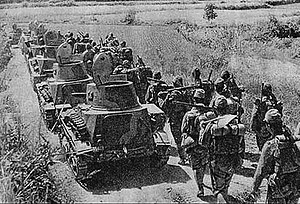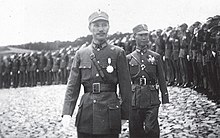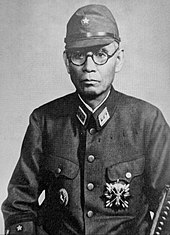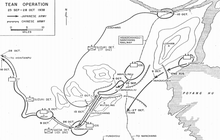Battle of Wuhan
Battle for Wuhan
Part of: Second Japanese-Chinese War

Japanese engineer troops with tankettes on the march near Naxi, Yangxin County, early October 1938.
Second Japanese-Chinese War (1937-1945)
1937-1939Marco Polo Bridge
- Beijing-Tianjin - Chahar - Shanghai (Sihang Warehouse) - Beijing-Hankou Railway - Tianjin-Pukou Railway - Taiyuan (Pingxingguan, Xinkou) - Nanking - Xuzhou (Tai'erzhuang) - Henan - Lanfeng - Amoy - Wuhan (Wanjialing) - Canton - Hainan - Nanchang - (Xiushui) - Chongqing - Suixian-Zaoyang - (Shantou) - Changsha (1939) - South Guangxi - (Kunlun Pass) - Winter Offensive - (Wuyuan)
1940-1942Zaoyang-Yichang
- Hundred Regiments - Central Hubei - Southern Henan - Western Hebei - Shanggao - Shanxi - Changsha (1941) - Changsha (1942) - Yunnan-Burma Road - Zhejiang-Jiangxi - Sichuan
1943-1945West Hubei
- North Burma and West Yunnan - Changde - Ichi-gō - Henan - Changsha (1944) - Guilin-Liuzhou - West Henan and North Hubei - West Hunan - Guangxi (1945) - Manchukuo (1945).
The Battle of Wuhan was a Japanese campaign of several months in the Second Sino-JapaneseWar, fought from June to October 1938 for possession of the temporary Chinese capital of Wuhan (then Hankou) against the National Revolutionary Army.
Background
The Second Sino-Japanese War, which began in July 1937, had initially brought the Japanese rapid successes in northeast China as well as against the then capital Nanjing and against Shanghai in the year of the war. The Chinese seat of government was then temporarily relocated to Wuhan in central China's Hubei province.
After the fall of Xuzhou in May 1938, the Japanese military leadership began to draw up concrete plans for a quick end to the war. At a cabinet meeting in July, the decision was made to attack the provisional Chinese capital of Wuhan and overthrow the Kuomintang government there. A simultaneous attack on Guangzhou (Canton) was intended to demonstrate to the Chinese that the Japanese military had the power to attack at any point and that further resistance was futile.
After the end of the Battle of Xuzhou, the Japanese had initially advanced further west along the Longhai Railway to take possession of Zhengzhou, the next important railway junction on the way to Wuhan. Here the Longhai Railway crosses the north-south railway line from Beijing to Wuhan. After reaching Kaifeng, some 70 kilometers from Zhengzhou, and threatening to continue their advance, Chiang Kai-shek, on the advice of Chen Guofu, ordered the destruction of the YellowRiver dams at Huayuankou in early June. The resulting floods affected three Chinese provinces (Henan, Anhui, and Jiangsu) and killed up to one million residents. The measure was justified on the grounds that it would avert an imminent threat to Wuhan. In fact, the capture of the city was only delayed for several months. In this way, the Japanese were prevented from advancing south along the Peking-Hankou railway. They chose instead to attack further south, in the Yangtze River valley. Here the action of the land troops could be supported by warships.
Preparations
The Japanese 2nd Army was withdrawn from operations at Zhengzhou and moved to Hefei. It was to advance north of the Yangtze River overland through the Dabie Shan area to reach the Zhengzhou-Hankou Railway north of Wuhan. The Chinese defenders, consisting of the troops of the 9th Military Region (General Chen Cheng) and the troops of the 5th Military Region (General Li Zongren) who had escaped from Xuzhou, numbered an estimated 800,000 men. South of the Yangtze River in southern Anhui Province and in northern Jiangxi Province, troops of the 3rd Military Region also opposed the Japanese.
The Battle of Wuhan was initiated on May 31, 1938, with an air battle over the city. In July and August the bombardment increased and finally led to the destruction of Chiang Kai-shek's headquarters. The German military advisors in China under Alexander von Falkenhausen left the city in early July.
The Japanese 11th Army was regrouped in early July from troops of the Central China Expeditionary Army; it was to advance farther south along the Yangtze River. By mid-July, the Japanese had about ten divisions, most of which were split into two armies (11th and 2nd Armies) for the attack on Wuhan. In total, this amounted to about 350,000 men, who received support from about 500 aircraft:
11th Army, Lieutenant General Yasuji Okamura
- 6th Division, Lieutenant General Shiro Inaba
- 101st Division, Lieutenant General Masaki Ito
- 106th Division, Lieutenant General Matsuura Junrokurō
- Hata Detachment, Major General Juichi Hata
- Taiwan Infantry Brigade, Major General Senshuu Shigetou
- 27th Division, Lieutenant General Masaharu Homma (from 15 July)
- 9th Division, Lieutenant General Ryousuke Yoshizumi (as of August 22)
- (Reserve) 116th Division, Lieutenant General Kiju Shimizu.
2nd Army, Prince Higashikuni Naruhiko
- 3rd Division, Lieutenant General Susumu Fujita
- 10th Division, Lieutenant General Yoshio Shinozuka
- 13th Division, Lieutenant General Rippei Ogisu...
- 16th Division, Lieutenant General Kesago Nakajima, from 15 July Keisuke Fujie
- 22nd Division, Lieutenant General Ichiji Dobashi (from 15 July)
National Chinese Army
9th Military District - Chen Cheng
3rd Army Group - Xue Yue
- 20th Army Group - Shang Zhen
- 9th Army Group - Wu Qiwei
- 29th Army Group - Li Hanhun
2nd Army Group - Zhang Fakui
- 30th Army Group - Wang Lingji
- 3rd Army Group - Sun Tongxuan
- 31st Army Group - Tang Enbo
- 32nd Army Group - Guan Linzheng
- Wuhan Garrison - Lo Cho-ying
5th Military District - Li Zongren
3rd Army Group - Sun Lianzhong
- 29th Army Group - Wang Tsan-hau
- 26th Army Group - Xu Yuanquan
- 21st Army Group - Liao Lei
4th Army Group - Li Pinxian
- 11th Army Group - Li Pinxian (simultaneously)
- 24th Army Group - Han Deqin
- 27th Army Group - Yang Sen
.jpg)
Li Zongren

Chiang Kai-shek and Chen Cheng at the inspection of troops

Okamura Yasuji

Japanese advance along the Yangtze River on Wuhan, June 1938.

Course of the war 1937

Situation in Central China, July 1938
History
Operations of the 2nd Army
The Japanese 2nd Army opened its offensive in August with an attack on Lu'an. In mid-September it reached Shangcheng and Huangchuan in southern Henan Province, and on October 10 it reached the railway line to Wuhan at Xinyang. From there it turned south toward Yingshan on the Hubei-Anhui border, which it reached in late October. By this time, Wuhan had already fallen to the troops operating in the Yangtze River valley.
Operations of the 11th Army
The 11th Army had begun their offensive on June 12 with attacks on Anqing. The city fell into their hands after only one day, and they gained access to an airfield here. In the last week of June, the heavily fortified Chinese position at Madang, which the Japanese had bombarded from the river with their warships and covered with poison gas, fell. Then, in late July, the important railway junction and river port of Jiujiang farther upriver, defended by 80,000 men under Generals Xue Yue and Zhang Fakui, fell to the Japanese after five days of fighting. There was a nervous tension among the Chinese defenders of Wuhan in the face of the unstoppable Japanese advance. Among the population, there was fear of a repetition of events like those that followed the capture of Nanjing, as repeated on a smaller scale in Jiujiang. A particularly hot summer and the humid river climate led to numerous casualties on both sides from diseases such as malaria and dysentery.
In late August, the 11th Army attacked along the shore of Lake Poyang and toward Yichang, capturing Ruichang. The Chinese soldiers stubbornly defended their positions despite the incessant Japanese bombardment and counterattacked as they did at Huangmei. The Japanese 106th Division was badly battered in the Battle of Wanjialing, which lasted until after the fall of Wuhan. It took the Japanese a full three weeks to gain 15 kilometers of space in September. The 106th Division was trapped in the Lushan Cauldron, and two more divisions, the 27th and 9th, had to be brought up to relieve those still able to fight, numbering about 1000. The fortress of Tianjiazhen held out for two weeks before it was captured by the Japanese, again by the use of poison gas. Although the Japanese army was victorious in terms of the entire operation, it suffered a Pyrrhic victory, suffering almost 30% casualties (over 100,000 men). In October, the two Japanese divisions operating furthest south succeeded in cutting the railway from Wuhan to Guangzhou (Canton). This sealed the city's fate. The Japanese 9th Division was able to break through the defenses of the Chinese 53rd and 32nd Corps and advanced into the Heshengqiao area south of Wuchang on October 24. The city of Wuhan, threatened from three sides, surrendered on October 25, four days after Guangzhou in southern China.

Battle of Wanyialing

Map of operations around Wuhan
Search within the encyclopedia